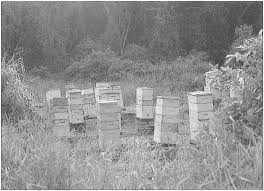Beekeeping in Hawaii
The honey bee can be found in almost every country in the world today. But this was not always the case.
Recent research into the genome of the honey bee seems to indicate the species originated in Asia and spread naturally across Europe and Africa. European settlers brought the first honey bees to the Americas in the 1600s. It would take another 250 years for the honey bee to make its way to the Hawaiian Islands, where I am now learning to be a beekeeper.
The History of Beekeeping in Hawaii started with several unsuccessful attempts to bring the honey bee to Hawaii in the 1850s. Most hives did not survive the trip around Cape Horn or died shortly after their arrival.
Then, in 1857 three hives of German dark bees were shipped from California to Honolulu. The colonies arrived to the Islands in good condition and were placed in the care of Dr. William Hillebrand in Nu’uanu Valley. There the colonies successfully established themselves and thrived. So much so that the three original hives had become nine hives by swarming in just one year. Other species of honey bee were brought to Hawaii soon afterwards. In 1880 the Italian honey bee was shipped successfully to the Islands from San Francisco.
German Black Bee (left) and Italian Honey Bee (right)
For many years these honey bees reproduced and became feral colonies with just a few hives maintained by hobbyist beekeepers.
Then in the late 1890s the interest in beekeeping rose dramatically.
Entrepreneurs from the US mainland found there was money to be made in ranching and introduced large numbers of cattle to Hawaii. Feed was needed to maintain the growing cattle population so the industry began the wide scale cultivation of Prosopis pallida, also known as mesquite and locally called kiawe.
Kiawe grows well in hot climates, produces nutritious beans for cattle feed, offers shade for roaming herds, makes sturdy wood for fences, and even burns slowly like charcoal. This made the tree very important to the cattle ranching industry. Honey bee hives were established near ranches to promote pollination and increase kiawe yield. It was found the kiawe nectar produced a very good light honey so commercial honey production soon followed. We currently sell it as our Naalehu Wild Flower Honey.
The first export of honey from Hawaii to the US mainland occurred in 1894. The shipment was for eight gallons of honey. By 1897 honey operations shipped 109,000 pounds. From 1905 to 1916 the average honey shipments amounted to $40,000 annually. This increased sharply to $356,536 in 1918. Prices for honey were high at this time averaging about fifteen cents per pound due to stimulated demand during World War I.
In 1930 a ranch on the Island of Molokai produced 500,000 pounds of Hawaiian Honey and was reported to be the world’s largest honey producer for that year.
Despite the success of this ranch during the 1920s and 1930s, three events occurred that led to the decline of the beekeeping industry in Hawaii.
Firstly, the price of honey dropped to an all time low of just three cents per pound due to the Depression.
Secondly, a disease called American Foulbrood was accidentally introduced in Maui in 1929 or 1930. This is a fatal honey bee disease caused by a spore forming bacteria. There is no cure. Infected hives must be burned. There was a mass burning of hives and by 1935 few viable honey operations were left on the Islands.
Lastly, the control of the sugarcane leafhopper reduced the amount of honeydew as an available nectar for honey bees. The leafhopper is a pest of the sugarcane plant.
It feeds on the sugarcane and produces a sweet excretion called honeydew. The honey bees found honeydew irresistible and it acted as a nectar substitute which increased honey yields. When the leafhopper was eradicated so was this nectar substitute.
Through the years businesses specializing in other bee related activities such as pollination services, bee removal, and queen rearing took hold in the Islands. The Garden Island Honey Company located on Kaua’i appeared to be the first beekeeping operation to commercially produce queen bees.
Hawaii offers ideal weather conditions for queen bee rearing year round. According to estimates made in 2012 by the Hawaii Apiary Program, Hawaii exports $10 million a year in queen bees, supplying about 25% of the queen bees in the US and 75% in Canada. To put this in perspective honey production on the Islands is valued at just over $3 million a year.
These figures show that the way forward for commercial beekeeping in Hawaii is likely to be rearing queen bees.
And I’m lucky enough to be learning how to do it! You can read about my experiences with rearing queen bees at the links below. Thanks for reading!

